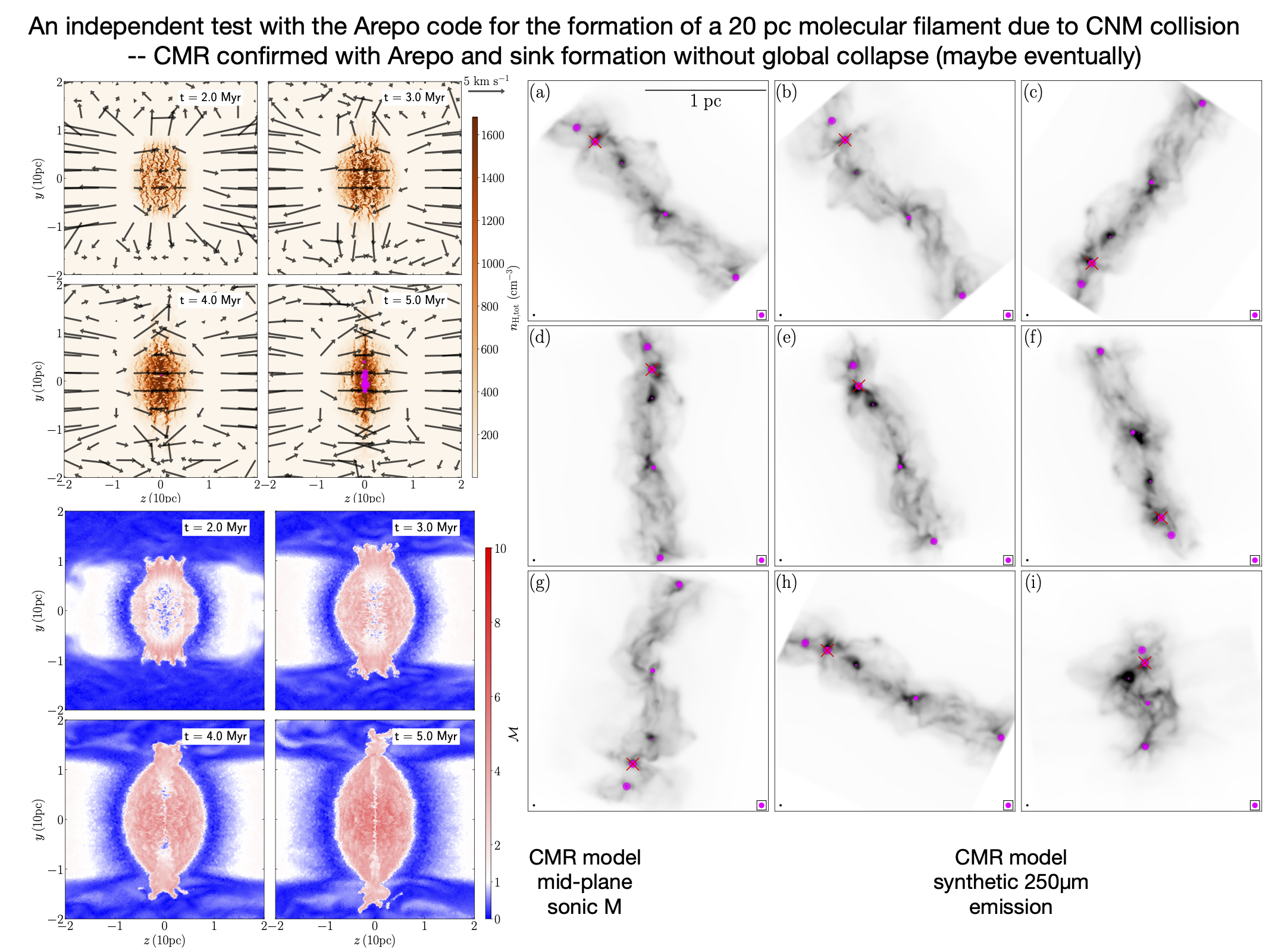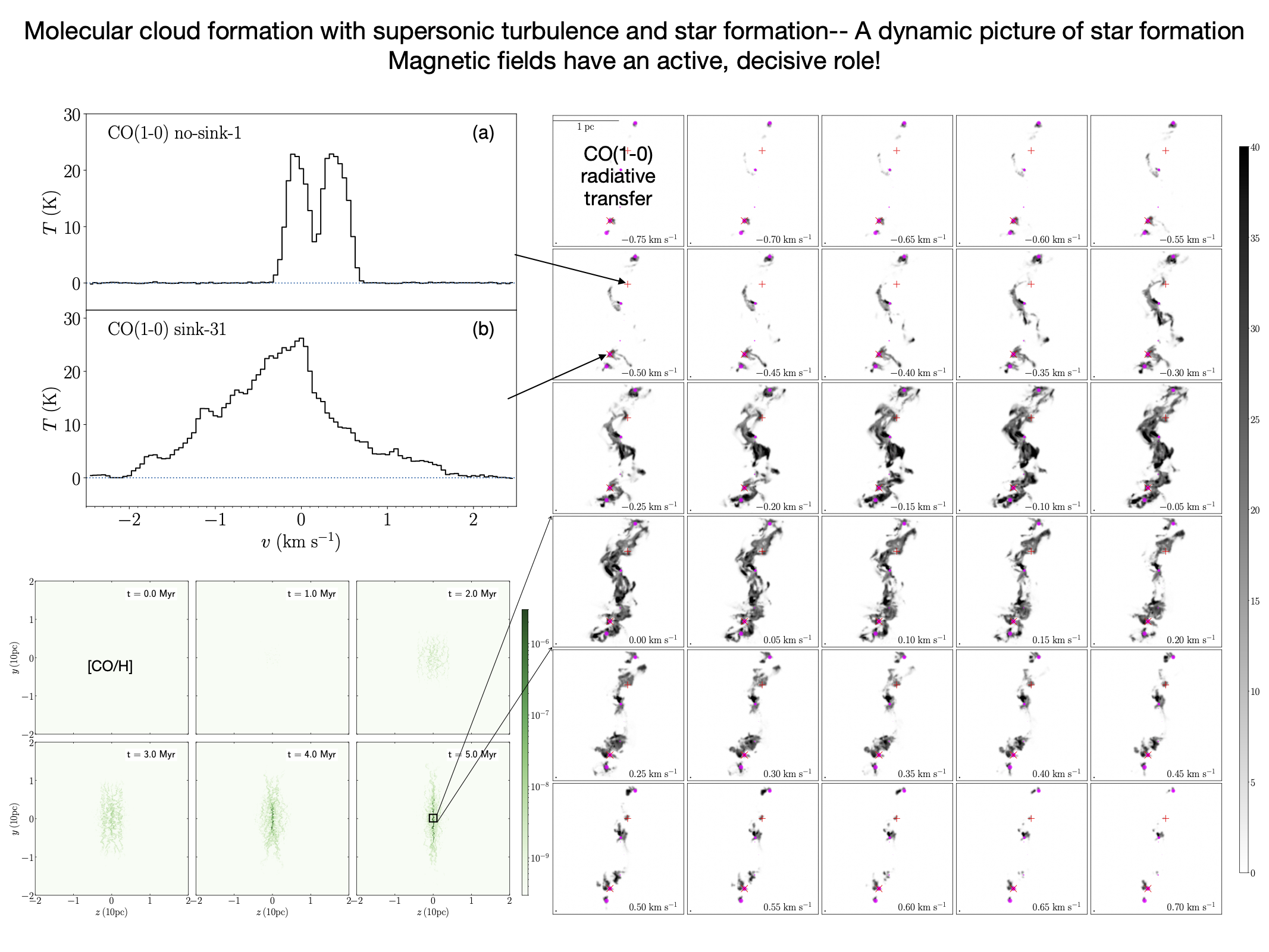The Collision-induced Magnetic Reconnection mechanism
I am interested in molecular cloud and star formation. Most recently, I am focusing on understanding the role of magnetic fields in the interstellar medium (ISM) through a combination of observational and theoretical approaches. The ISM, a major constituent of the Galaxy and an active participant in the baryon cycle, is essentially a plasma that is threaded with magnetic fields. As such, understanding the interplay between magnetic fields and the ISM is crucial. Traditional studies have often emphasized the resistance of magnetic fields to gas condensation, portraying them as playing a primarily passive role. This view is part of the reason that magnetic fields were thought to be secondary in star formation and galaxy evolution. To expand this perspective, I take a different approach by exploring an active role of magnetic fields. Specifically, by modeling the novel Collision-induced Magnetic Reconnection (CMR) mechanism, I show that magnetic fields can actively condense interstellar gas into star-forming clouds. The new model, firmly based on observational motivations, suggests that magnetic fields can be dynamically decisive, offering a missing piece in our understanding of the interplay between magnetic fields and the ISM.
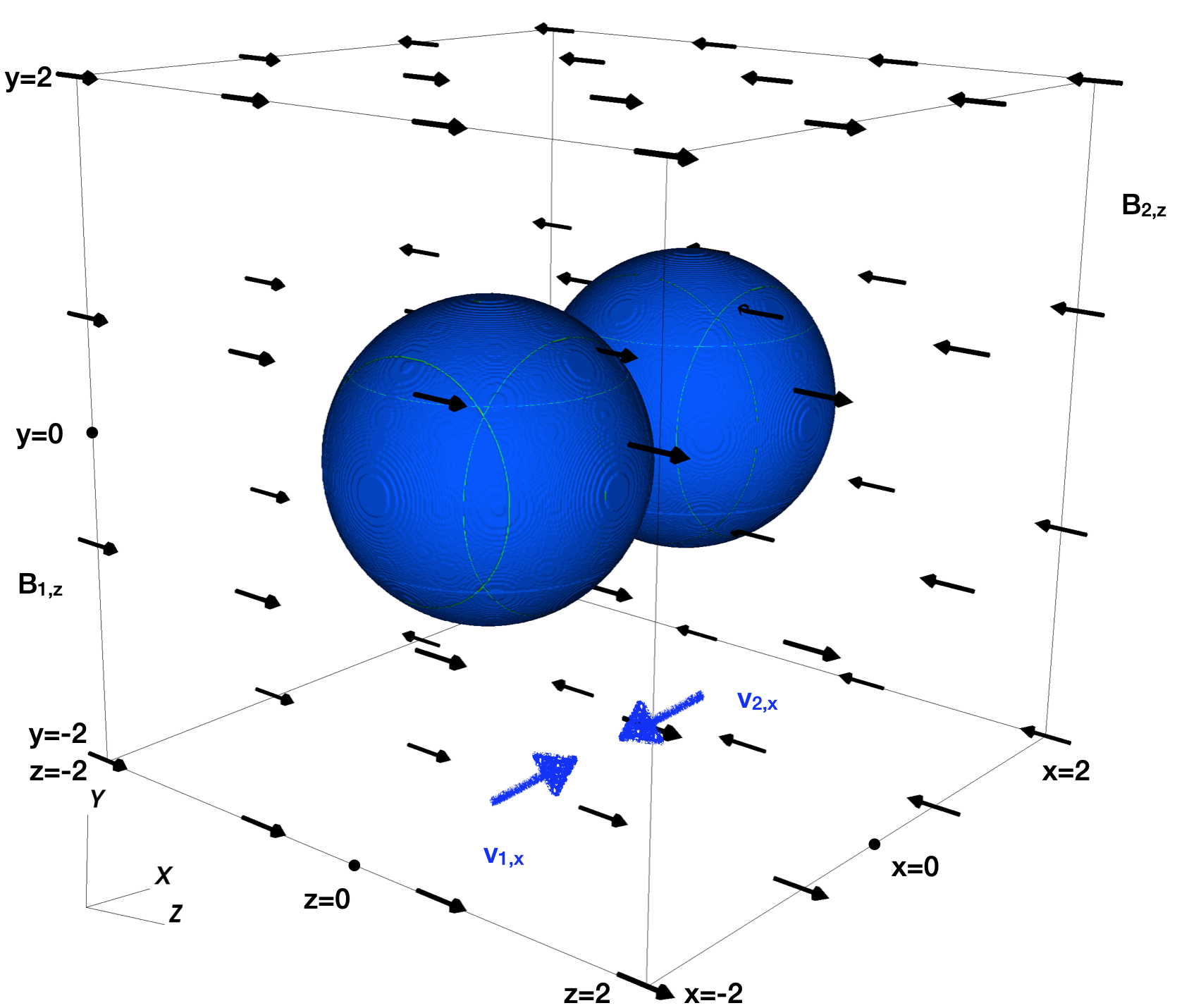
A movie showing the filament formation via CMR. The simulation data is from the fiducial model MRCOL from Kong et al. (2021, ApJ, 906, 80) in which I proposed CMR for the first time to explain the formation of the Stick filament in the Orion A giant molecular cloud. As the collision continues along x-axis, more dense gas forms in the pancake (y-z plane or the collision midplane) which is continuously transported to the central filament. At the end, helical fields wrap around the filament with confining surface pressure. Formation of dense cores and stars shall follow in the filament.
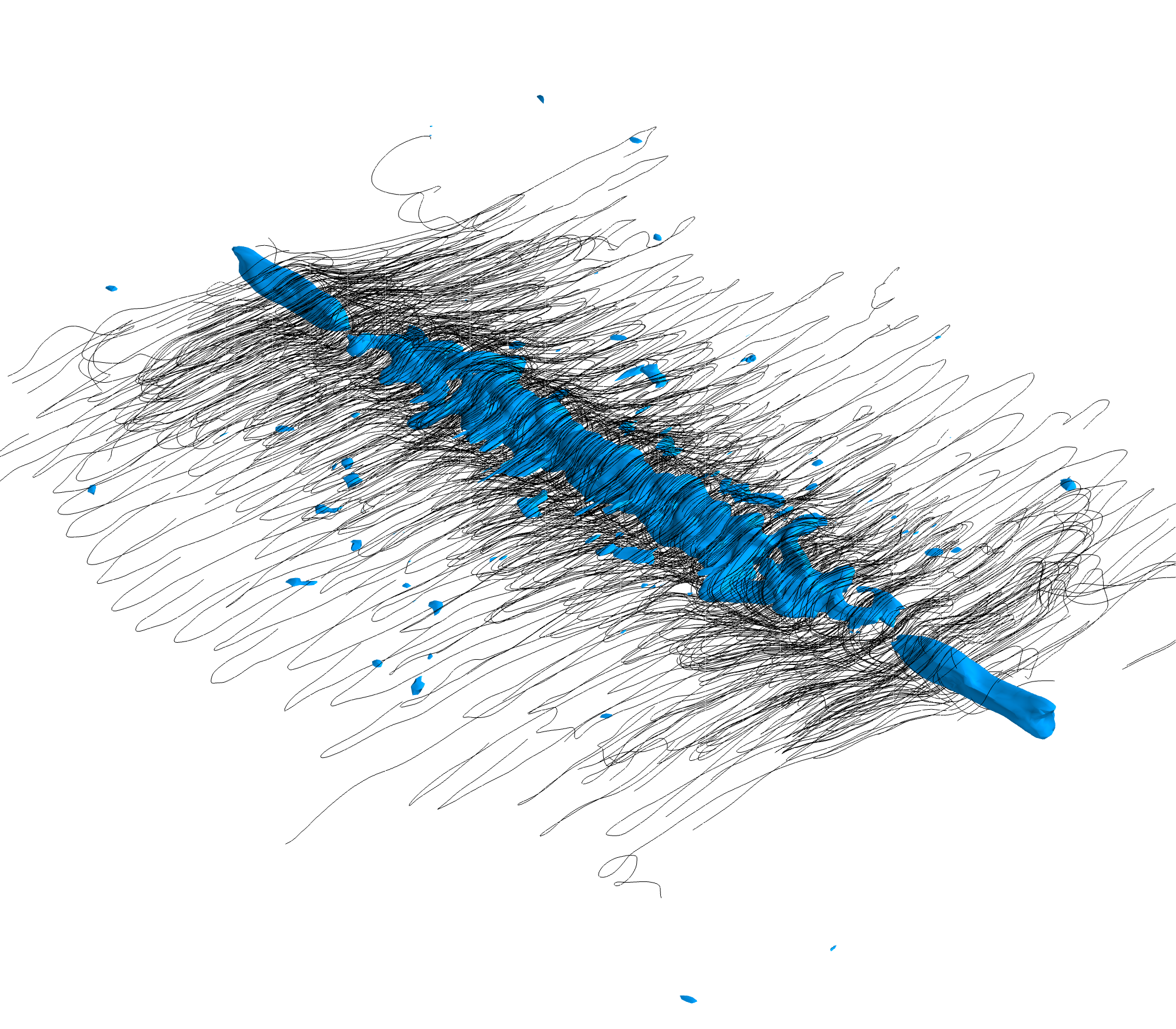
While going through the CARMA-NRO survey C18O data cube, I noticed a special filament (the Stick) at the southern end of the integral-shaped filament. It shows ring-like fibers at different velocity channels (see left column in the figure below). These ring-like fibers resemble those structures in magnetic reconnection simulations, which motivated me to model the filament formation in the context of magnetic reconnection. To my surprise, the 15-year-long effort by Dr. Carl Heiles who observed the HI Zeeman effect (Heiles (1997), ApJS, 111, 245) showed a reverse magnetic field on two sides of the Orion A cloud. This field-reversal is a necessary condition for CMR. Considering other observational facts such as the double-velocity spectral feature and the perpendicular plane-of-the-sky magnetic fields (e.g., Soler (2019), A&A, 629, 96), the only initial condition for the model is a setup like the right panel in the figure below. So I used the Athena++ code to set up a collision simulation between two spherical diffuse clouds (we always start with spheres:) with reverse magnetic fields (see the left panel in the top figure).

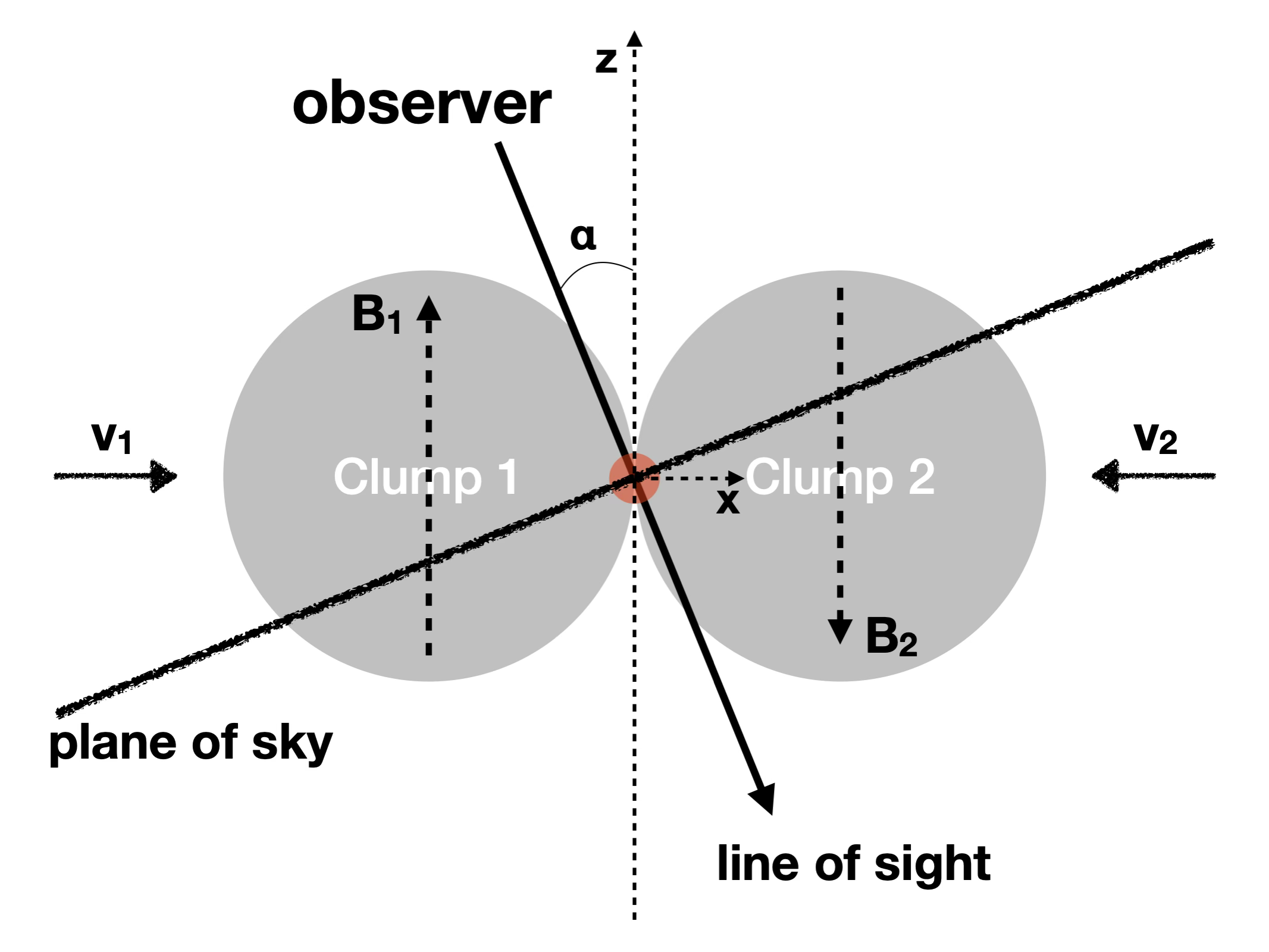
Surprisingly, instead of forming a compressed “pancake” structure,
the collision resulted in the formation of a filament. This outcome
contrasts with the intuitive expectation that a head-on collision
between two spherical bodies would simply create a flattened
structure at the center. However, a closer examination of a
simulation slice revealed that a pancake did initially form.
Soon after, it became wrapped by magnetic field loops, which
exerted strong tension and gradually squeezed the pancake material
toward the central axis, forming the filament. In other words,
the filament formation does not need gravity!
Although, gravity will take over with the growth of the
filament mass, as long as the cloud collision continues.
The figure below illustrates the formation of these magnetic loops.
The collision triggered magnetic reconnection on both sides of the
pancake, generating two half-loops and a full loop. The half-loops
pulled gas outward, while the full loop compressed the pancake inward.
As the collision progressed, ongoing reconnection continuously
funneled dense gas into the central filament. This dynamic process
is shown in the movie in the top figure.

Using the model filament, I performed synthetic observations and compared the resulting radiative transfer images with actual observational data. The model showed strong agreement with observed features, including the column density distribution, the position-velocity diagram, and overall morphological characteristics. Notably, it provided a natural explanation for the observed reversed magnetic field. An intriguing implication emerged from this analysis: the structures within the CMR filament appear to be confined by surface magnetic pressure. This finding aligns with the conclusion of Kirk et al. (2017), which suggests that dense cores in Orion are primarily pressure-confined.
To investigate whether a filament like the Stick can form stars, we used the Arepo code with sink formation to repeat the above Athena++ simulation. First, the filament formation was reproduced in the Arepo simulation, so that CMR was independently confirmed with a different code. Second, the filament collapsed and formed a star cluster, but only after the filament became massive enough. An intriguing finding was that the star formation rate in CMR was a factor of two lower than a control model without CMR. The lower rate was due to the surface magnetic field that acted like a shield and hindered gas inflow. The result was reported in Kong et al. (2022), MNRAS, 517, 4679.
In Kong et al. (2023), ApJ, 265, 58, I led a brief parameter exploration of CMR to see how different initial conditions affect the filament property. Again, I used Athena++ for the simulations, following the 2021 Stick paper. A notable finding was that a curved filament would form if the initial colliding clouds have different radii or different density.
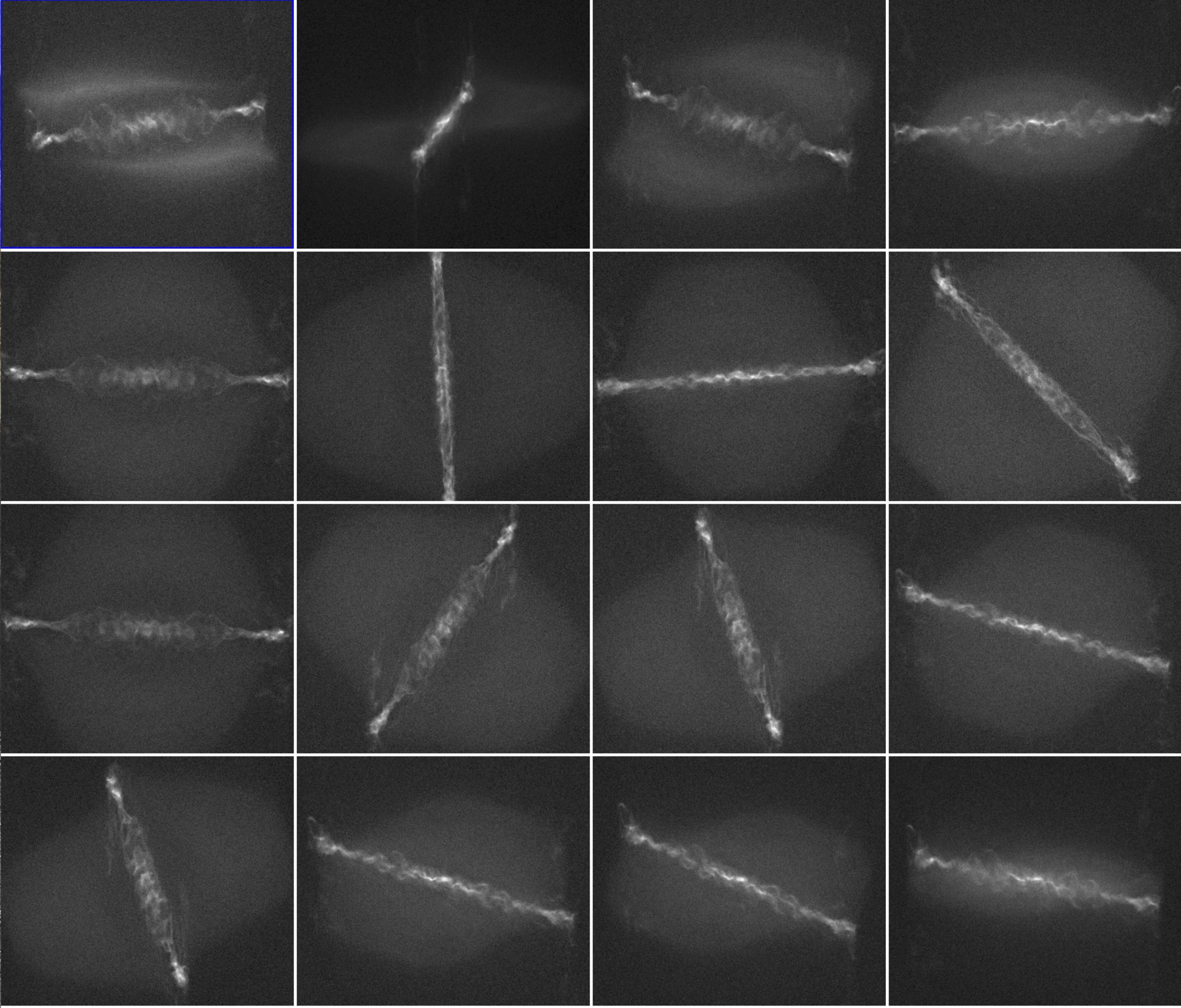
Using the exploration data, Dr. Duo Xu utilized machine-learning techniques to capture the morphological features of CMR filaments. Then, we applied the machine-learning models to the Herschel far infrared images of several filamentary clouds, including the Taurus cloud, the Orion cloud, and the Auriga–California Cloud. Several filamentary structures of these clouds were identified as CMR filaments. The findings were reported in Xu et al. (2023). Notably, these clouds were reported to have reverse magnetic fields (Tahani (2022) and private communication).
The MRCOL simulation began with molecular gas collision. A natural follow-up question is whether collisions between atomic gas can also lead to molecular cloud formation. In Kong et al. (2024), ApJ, 975, 97, we used Arepo again to model CMR within the cold neutral medium (CNM). The results showed that a filamentary molecular cloud successfully formed. This cloud exhibited numerous fiber-like substructures, with sinks actively accreting material through streamers. Recall from Kong et al. (2022), that sink accretion was only possible through streamers, as surface magnetic fields inhibited free gas inflow. Remarkably, this behavior persisted at a much larger scale (20 pc), with all sinks in the molecular cloud accreting via streamers. Most notably, the molecular cloud was naturally turbulent, driven by reconnected magnetic fields that funneled gas into the filament at supersonic (Alfvénic) speeds. This process compressed and transported shocked gas into the filament in a piece-by-piece manner. Consequently, filament formation in this scenario follows a bottom-up process -- distinct from the traditional top-down view of star formation, where gravity collects diffuse gas into a molecular cloud, which then collapses and fragments into clumps and cores. Remember, CMR filament formation proceeds without the need for gravity. In Kong (2022), ApJ, 933, 40, I also explored CMR in warm neutral medium in a disk galaxy.
